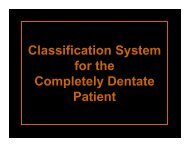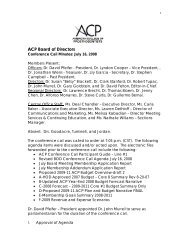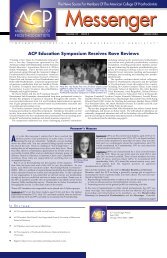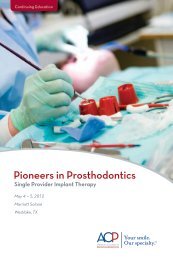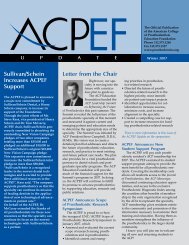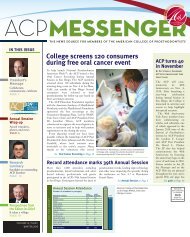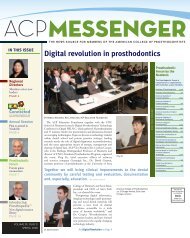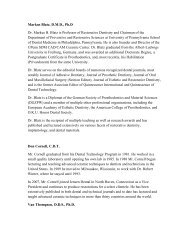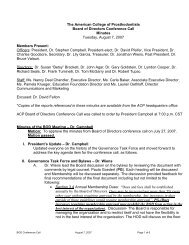PROSTHODONTICS - American College of Prosthodontists
PROSTHODONTICS - American College of Prosthodontists
PROSTHODONTICS - American College of Prosthodontists
You also want an ePaper? Increase the reach of your titles
YUMPU automatically turns print PDFs into web optimized ePapers that Google loves.
52 Parameters <strong>of</strong> Care Tupac et alRufenacht CR. Fundamentals <strong>of</strong> Esthetics. Chicago, Quintessence, 1990Sheets CG, Taniguchi T: Advantages and limitations in the use <strong>of</strong> porcelain veneer restorations. J Prosthet Dent 1990;64:406-411Simon H, Raigrodski AJ: Gingiva-colored ceramics for enhanced esthetics. Quint Dent Technol 2002;25:155-172Tarnow DP, Magner AW, Fletcher P: The effect <strong>of</strong> the distance from the contact point to the crest <strong>of</strong> bone on the presence orabsence <strong>of</strong> the interproximal dental papilla. J Periodontol 1992;63:995-996Thanos C, Friedman MH, Sorensen J, et al: 1990 USC esthetic dentistry symposium. J Calif Dent Assoc 1990;18:13-17Tjan AH, Miller GD, The JG: Some esthetic factors in a smile. J Prosthet Dent. 1984;51:24-28Touati B, Miara P, Nathanson D: Esthetic Dentistry and Ceramic Restorations. London, Martin Dunitz, 1999Weinstein AR: Bleaching, bonding, and veneering: a rationale for material and technique choice. Pract Periodontics Aesthet Dent1991;3:34-41Weinstein AR: Esthetic applications <strong>of</strong> restorative materials and techniques in the anterior dentition. Dent Clin North Am1993;37:391-409Williamson RT: Techniques for aesthetic enhancement <strong>of</strong> porcelain laminate veneer restorations: a case report. Pract PeriodonticsAesthet Dent 1994;6:73-78Yamada K: Porcelain laminate veneers for discolored teeth using complimentary colors. Int J Prosthodont 1993;6:242-247Preface9) Temporomandibular Disorders Parameter“Temporomandibular disorders’’ (TMD) is the most universal term being used today to represent ahost <strong>of</strong> problems associated with the temporomandibular joint, the surrounding masticatory and relatedmusculature, and other contiguous tissue components. Patients with these problems are appropriatelytreated by prosthodontists.General Criteria and StandardsInformed Consent: All prosthodontic procedures should be preceded by the patient’s consent. Informedconsent is obtained after the patient has been informed <strong>of</strong> the indications for the procedure(s), goals<strong>of</strong> treatment, the known benefits and risks <strong>of</strong> the procedure(s), the factor(s) that may affect the knownrisks and complications, the treatment options, the need for active maintenance by the patient, the needfor future replacements and revisions, and the favorable outcome.Documentation: Parameters <strong>of</strong> care for prosthodontic procedures include documentation <strong>of</strong> objectivefindings, diagnosis, and patient management intervention.Coding and NomenclatureDiagnostic and procedural codes have been included in the ACP Parameters <strong>of</strong> Care only for generalguidance. The codes listed may not be all-inclusive or represent the most current or specific choices. Theinclusion <strong>of</strong> codes is not meant to supplant the use <strong>of</strong> current coding books or to relieve practitioners<strong>of</strong> their obligation to remain current in diagnostic and procedural coding. The ACP Committee onParameters <strong>of</strong> Care and Committee on Nomenclature do not endorse the use <strong>of</strong> this document as acoding manual.The diagnostic and procedural codes listed throughout this section may not be all-inclusive and shouldserve only as practice guidelines. ICD-9-CM (International Classification <strong>of</strong> Diseases, Ninth Revision, ClinicalModification) diagnostic codes may change yearly and must be reviewed and updated annually to ensureaccuracy. Specific diagnoses must be obtained from a current, recognized ICD-9-CM code source andsubstantiated by documentation in the dental record. Procedural codes listed throughout this sectionserve as a guide, which may be applicable to the treatment performed or management modality chosen.These may not be the most recent, applicable, or acceptable codes. Some dental/medical insuranceproviders have billing conventions unique to their organizations. It is the provider’s responsibility to beaware <strong>of</strong> these unique situations.Current Procedural Terminology (CPT), the recognized codes for dental/medical billing, are revisedyearly and must be reviewed and updated annually to ensure accuracy. The recent codes are accepted2010 CDEL Re-recognition <strong>of</strong> the Specialty Report 92 <strong>of</strong> 279



